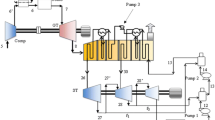Abstract
Various issues of increasing the thermodynamic efficiency of generation of produced energy carriers, such as water, hydrogen or compressed air are considered. The proposed technology, called multi-generation, is based on the creation of energy complexes consisting of generation facilities and consumers. The task of generation facilities is to manufacture, along with the traditional energy carriers, such as electricity and heated liquid, other produced energy carries and useful products. In the case of separate generation, they would have been generated either at consumers or at targeted enterprises.
The advantages of the multi-generation technology implementation are shown for individual generation facilities and consumers, as well as for the energy supply system as a whole. The change in the specific fuel consumption for electricity and heat production is taken as a criterion for evaluating the thermodynamic efficiency for a separate generation facility. For the power supply system, the criterion is the absolute and relative changes in the exergy efficiency of generation of all produced energy carriers. Formulas for comparative calculation of efficiency for combined and separate generation at accepted evaluation criteria are derived.
The accepted conditions and results of calculations of changes in the efficiency of generation of produced energy carriers at the transition from separate to combined generation for the energy complex consisting of the T-100-130 steam turbine unit combined with vapor compression and ammonia-water absorption refrigerating machines are presented.
Similar content being viewed by others
References
G. Chicco and P. Mancarella, Distributed multi-generation: a comprehensive view, Renewable and Sustainable Energy Reviews, 2009, Vol. 13, No. 3 P. 535–551.
P. Mancarella, MES (multi-energy systems): an overview of concepts and evaluation models, Energy, 2014, Vol. 65, P. 1–17.
K. Jana, A. Ray, M.M. Majoumerd, M. Assadi, and S. De, Polygeneration as a future sustainable energy solution — a comprehensive review, Applied Energy, 2017, Vol. 202, P. 88–111.
R.Z. Aminov, A.N. Bairamov, and O.V. Shatskova, Assessment of the efficiency of hydrogen cycles on the basis of off-peak electrical energy produced by a nuclear power station, Thermal Engineering, 2009, Vol. 56, No. 11 P. 940–945.
B.G. Tuvalbaev, Long-term prospects for the use of thermal power station, Energy Saving and Water Treatment, 2010, No. 4, P. 2–5.
B.G. Tuvalbaev and V.I. Moiseyev, Work of the thermal power plant continuously with the generation of additional products by unused energy, Energy Saving and Water Treatment, 2013, No. 4, P. 24–27.
B.G. Tuvalbaev and V.I. Moiseyev, The use of oxygen co-production of additional generation in the technological process of thermal power plants, Energy Saving and Water Treatment, 2014, No. 4, P. 40–43.
A.V. Klimenko, V.S. Agababov, A.A. Rogova, and P.A. Tideman, Specific features of combined generation of electric power, heat, and cold by combined-cycle plants, Thermal Engineering, 2015, Vol. 62, No. 3 P. 166–170.
B.G. Tuvalbaev, M.E. Marchenko, E.M. Marchenko, and D.Sh. Valitov, Conceptual directions of development of power engineering, Energy Saving and Water Treatment, 2017, No. 3, P. 3–9.
V.M. Brodyansky, Exergy Method of Thermodynamic Analysis, Energiya, Moscow, 1973.
Typical performance standard of the T-100-130 TMZ turbine unit, in: State Technical Specifications for operation of power engineering systems, Ministry of Energy of the USSR, Moscow, 1971.
Author information
Authors and Affiliations
Corresponding author
Additional information
This work was financially supported by the Ministry of Education and Science of the Russian Federation under the state contract within the competition of research projects of research groups of research centers and scientific laboratories, as well as institutions of higher education (application number 13.3233.2017/PCh) and by the Council for grants of the President of the Russian Federation within the framework of the scholarship of President of the Russian Federation for young scientists and postgraduates within the scientific project No. SP-1141.2018.1.
Rights and permissions
About this article
Cite this article
Klimenko, A.V., Agababov, V.S., Koryagin, A.V. et al. Comparing thermodynamic efficiency of power supply systems with separate and combined generation of produced energy carriers. Thermophys. Aeromech. 26, 769–780 (2019). https://doi.org/10.1134/S0869864319050147
Received:
Revised:
Accepted:
Published:
Issue Date:
DOI: https://doi.org/10.1134/S0869864319050147




